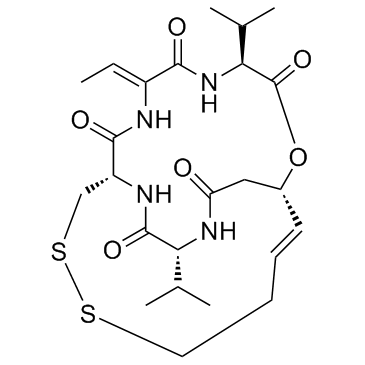Romidepsin (FK228, Depsipeptide)

Romidepsin (FK228, Depsipeptide) structure
|
Common Name | Romidepsin (FK228, Depsipeptide) | ||
|---|---|---|---|---|
| CAS Number | 128517-07-7 | Molecular Weight | 540.696 | |
| Density | 1.2±0.1 g/cm3 | Boiling Point | 942.8±65.0 °C at 760 mmHg | |
| Molecular Formula | C24H36N4O6S2 | Melting Point | 219-224°C | |
| MSDS | USA | Flash Point | 524.0±34.3 °C | |
|
Induction of MAPK- and ROS-dependent autophagy and apoptosis in gastric carcinoma by combination of romidepsin and bortezomib.
Oncotarget 7 , 4454-67, (2016) Proteasome inhibitors and histone deacetylase (HDAC) inhibitors can synergistically induce apoptotic cell death in certain cancer cell types but their combinatorial effect on the induction of autophagy remains unknown. Here, we investigated the combinatorial ... |
|
|
Non-epigenetic function of HDAC8 in regulating breast cancer stem cells by maintaining Notch1 protein stability.
Oncotarget 7 , 1796-807, (2016) Here, we report a novel non-epigenetic function of histone deacetylase (HDAC) 8 in activating cancer stem cell (CSC)-like properties in breast cancer cells by enhancing the stability of Notch1 protein. The pan-HDAC inhibitors AR-42 and SAHA, and the class I H... |
|
|
Valproic acid potentiates the anticancer activity of capecitabine in vitro and in vivo in breast cancer models via induction of thymidine phosphorylase expression.
Oncotarget 7 , 7715-31, (2016) The prognosis of patients with metastatic breast cancer remains poor, and thus novel therapeutic approaches are needed. Capecitabine, which is commonly used for metastatic breast cancer in different settings, is an inactive prodrug that takes advantage of ele... |
|
|
Profiling the anti-protozoal activity of anti-cancer HDAC inhibitors against Plasmodium and Trypanosoma parasites.
Int. J. Parasitol. Drugs Drug Resist. 5 , 117-26, (2015) Histone deacetylase (HDAC) enzymes work together with histone acetyltransferases (HATs) to reversibly acetylate both histone and non-histone proteins. As a result, these enzymes are involved in regulating chromatin structure and gene expression as well as oth... |
|
|
Identification of Novel Small Organic Compounds with Diverse Structures for the Induction of Epstein-Barr Virus (EBV) Lytic Cycle in EBV-Positive Epithelial Malignancies.
PLoS ONE 10 , e0145994, (2015) Phorbol esters, which are protein kinase C (PKC) activators, and histone deacetylase (HDAC) inhibitors, which cause enhanced acetylation of cellular proteins, are the main classes of chemical inducers of Epstein-Barr virus (EBV) lytic cycle in latently EBV-in... |
|
|
Histone deacetylase–mediated silencing of AMWAP expression contributes to cisplatin nephrotoxicity.
Kidney Int. 89 , 317-26, (2016) Cisplatin-induced acute kidney injury is a serious problem in cancer patients during treatment of solid tumors. Currently, there are no therapies available to treat or prevent cisplatin nephrotoxicity. Since histone deacetylase (HDAC) inhibition augments cisp... |
|
|
In Vitro Reactivation of Replication-Competent and Infectious HIV-1 by Histone Deacetylase Inhibitors.
J. Virol. 90 , 1858-71, (2016) The existence of long-lived HIV-1-infected resting memory CD4 T cells is thought to be the primary obstacle to HIV-1 eradication. In the search for novel therapeutic approaches that may reverse HIV-1 latency, inhibitors of histone deacetylases (HDACis) have b... |